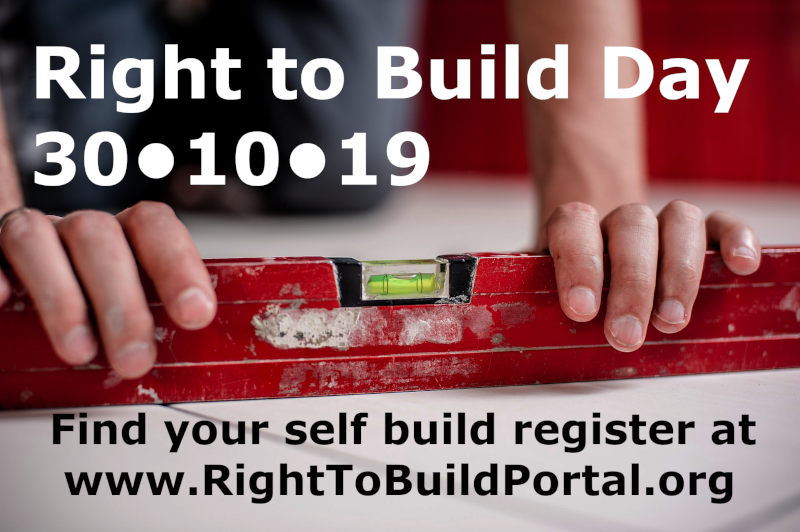The 30th October 2019 is a crucial date for all English local authorities as it is the first date ever that they have to demonstrate that they have granted enough permissions for the 18,000 people that signed up to the Right to Build in its first year of existence. These are the people that signed their local self build registers, held by their council, to demonstrate that they were interested in building their own home.
The registers are a little complicated in how they work, but essentially the 30 October each year is a cut off point for when planning authorities need to show that they have acted. Each ‘base’ period works on a rolling three-year period – meaning that from the close of the first register year (the 30 October 2016) councils had three years to act. So the Right to Build Day is the first time we get to see how many plots have actually been granted permission to be built upon.
For the first year this figure was 18,000 – so on 30 October 2019 the authorities should (!) demonstrate that they have granted enough planning permissions to reflect this demand.
To find out what’s happening, the National Custom and Self Build Association (NaCSBA) conducts a Freedom of Information request to all English authorities, including county, borough and district councils and national parks. Its last request illustrated that, at October 2018, council’s Custom and Self Build activity across the country is very mixed, creating a postcode lottery of provision.
Right to Build Day will trigger the next piece of research. NaCSBA will be tracking activity, finding out the self build heroes and the ‘could-try-harder’ councils, and be sharing this information with you, the industry and, importantly, government in an attempt to get a more even spread of activity.
Find out more about NaCSBA’s Right to Build Day campaign.
NaCSBA believes that Custom and Self Build gives more people more choice in the types of home, and what’s it can help encourage the build out of housing as it diversifies supply – an important goal for government as it works to get more 300,000 new homes a year by the mid 2020s.
Andrew Baddeley-Chappell, CEO, National Custom and Self Build Association said: “We’ve had to wait a long time since the legislation was passed to find out how effective it has been – and Right to Build Day will help clarify the picture. Our annual research and the work of the Right to Build Task Force has helped us to identify good, bad and some downright ugly performance from Local Authorities, and we will hold the government to its commitment to consider taking further action including possible changes to legislation if they do not believe sufficient action is being taken.
“Ongoing annual targets will mean local authorities will now need to continue to ensure a regular pipeline of new plots, enabling more wonderful new homes to be built and in doing so create a virtuous cycle of increased public awareness, increased opportunities and increased supply of custom and self build homes. The UK’s period at the bottom of the world league for the numbers of custom and self build homes may at last be coming to an end.”
The Right to Build – facts:
*The ‘Right to Build’ places two legal obligations on Local Authorities in England:
1. Under the Self-build and Custom Housebuilding Act 2015 all Local Authorities in England must keep a register of people and groups of people who are seeking to purchase serviced plots of land in the authority’s area and to have regard to that register when carrying out their functions. Registers were required from 1st April 2016.
2. The Housing and Planning Act 2016 requires all Local Authorities in England to grant sufficient ‘development permissions’ to meet the demand for Custom and Self Build housing in their area, as established by their register, on a rolling basis. Permissions equivalent to the number of people registering from 1st April 2016 to 30th October 2016 should be granted by 30th October 2019. Permissions equivalent to the number of people registering from 30th October 2016 to 30th October 2017 should be granted by 30th October 2020 and so on. This includes 18,000 permissions by 30th October 2019.
The Right to Build myths:
There are many misconceptions about the registers:
- Signing your self build register means that the planning authority must find you a plot – this is incorrect, as local authorities just need to grant planning permission for one plot to reflect your demand as one person wanting to build,
- You can only sign a single register – this is incorrect you can sign as many self build registers as you want, but some charge and some have local connection tests to limit this.
- Councils must ‘create’ plots – incorrect, local authorities have to grant planning permission on plots rather than bring them on themselves, although some councils do do this.
- Councils have to manage their own register – again this is not true, councils have a duty to have a register, but can ask a third-party to run and manage it for them,
- Councils must link people wanting plots with landowners and developers that have plots – again, incorrect. Unfortunately the legislation requires councils to run a list as a source of evidence for appetite for self building, but not to facilitate this directly by running a service that connects people up.
So why sign the registers?
The Right to Build registers are vital for alerting councils about demand – and they have to consider this. So by signing up you’re ensuring that more Custom and Self Build happens in your local area. And the more it happens, the more it becomes normal and accessible, with more people considering it as a route to a new home.
Images: pixabay





